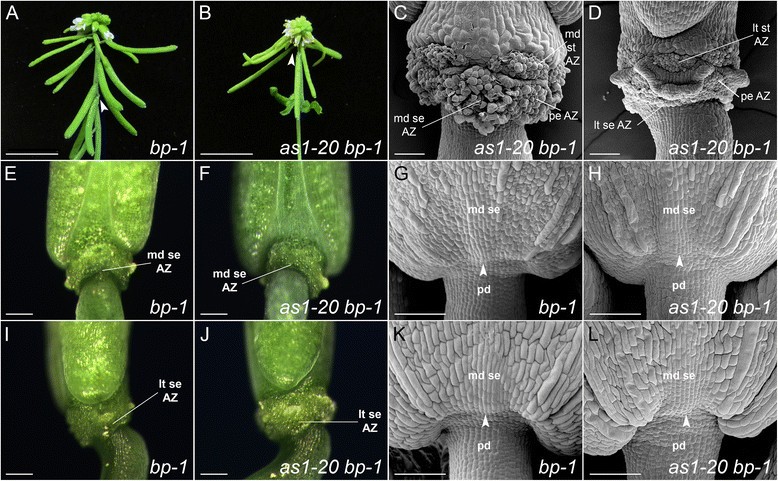Figure 5
From:ASYMMETRIC LEAVES1 regulates abscission zone placement inArabidopsisflowers

Loss ofBPrestores abscission zone placement and the position of the medial sepal-receptacle boundary inas1mutant flowers. A:bpinflorescence. The flower pedicels are short, slender and point downward.B:as1 bpinflorescence. Abscission of the medial sepals is not delayed.C/D: Scanning electron micrographs ofas1 bpflowers (stage 17) showing medial(C)and lateral(D)views. Placement of the abscission zones inas1 bpflowers(D)is similar to that of wild-type (see Figure2A, E). The abscission zones ofas1 bpflowers(C), as previously reported forbp-101, bp-3 and bp-10flowers [21],[25], show increased cell expansion during fruit development.E/F/I/J: Medial(E/F)and lateral(I/J)views ofbpandas1 bpflowers (stage 17). The positions of the enlarged abscission zones ofbp(E/I)andas1 bp(F/J)flowers are similar to those of wild-type flowers (see Figure3A, E).G/H/K/L: Scanning electron micrographs ofbpandas1 bpmedial sepal primordia. Boundary regions between the medial sepal primordia and underlying flower pedicels are indicated by arrowheads.G:Inbpflowers (stage 9), the pedicels are slender and the receptacle region beneath the floral organs fails to expand.H:Displacement of the sepal-receptacle boundary is not evident inas1 bpflowers (stage 9) orbpflowers(G).K/L: Due to radial constriction of the pedicel, the boundary between the sepals and receptacle is less distinct inbp(K)andas1 bp(L)flowers (stage 11). Scale bars: 1°Cm(A/B); 100 μm(C/D/G/H/K/L); 200 μm(E/F/I/J).
